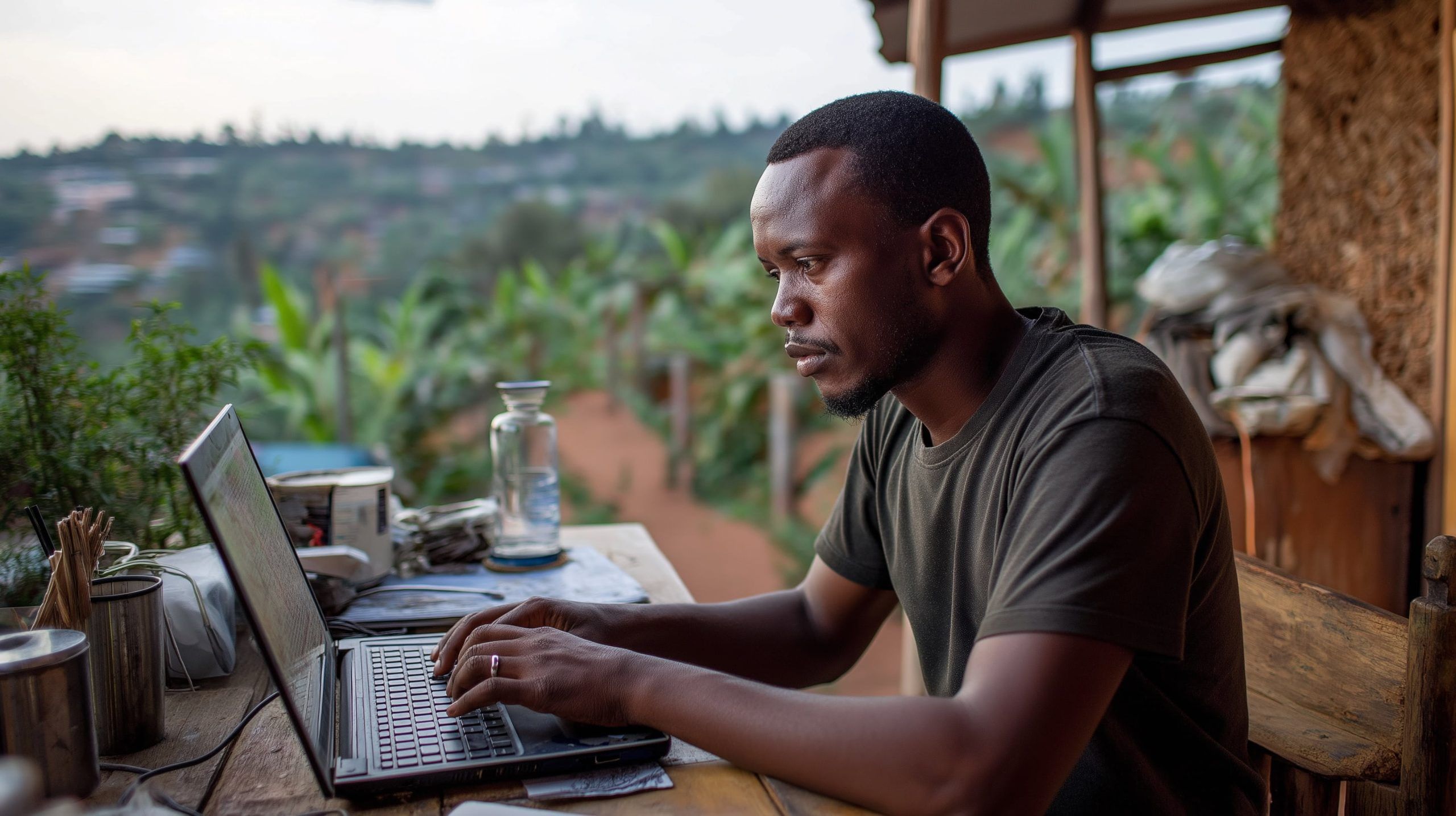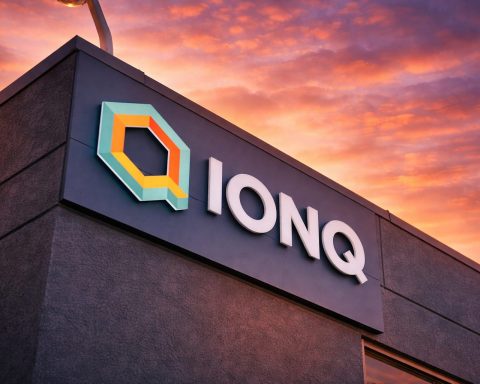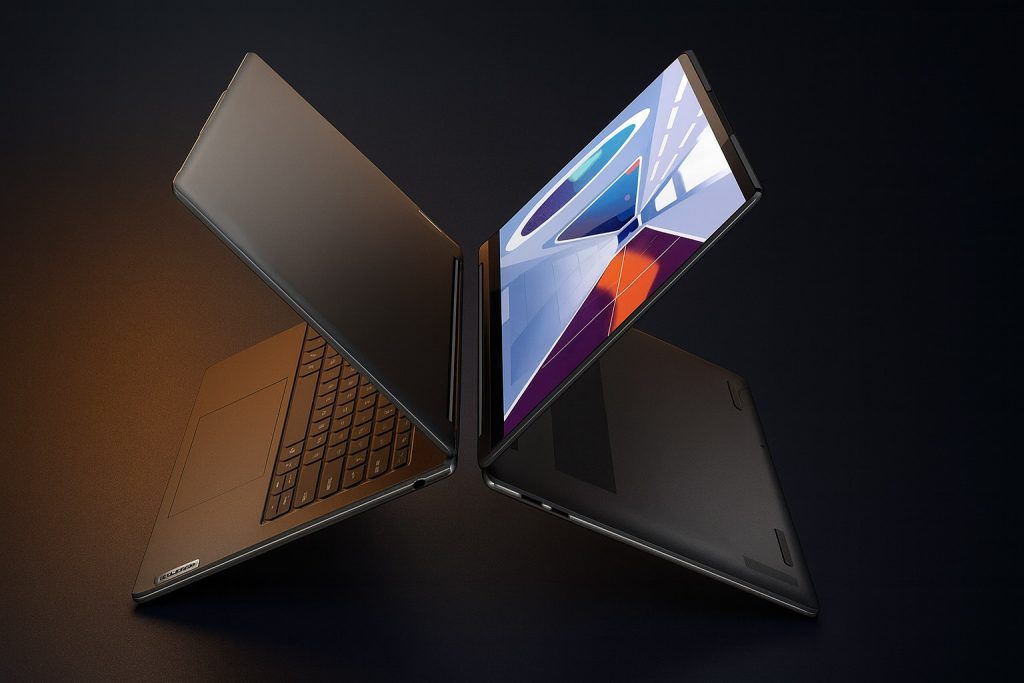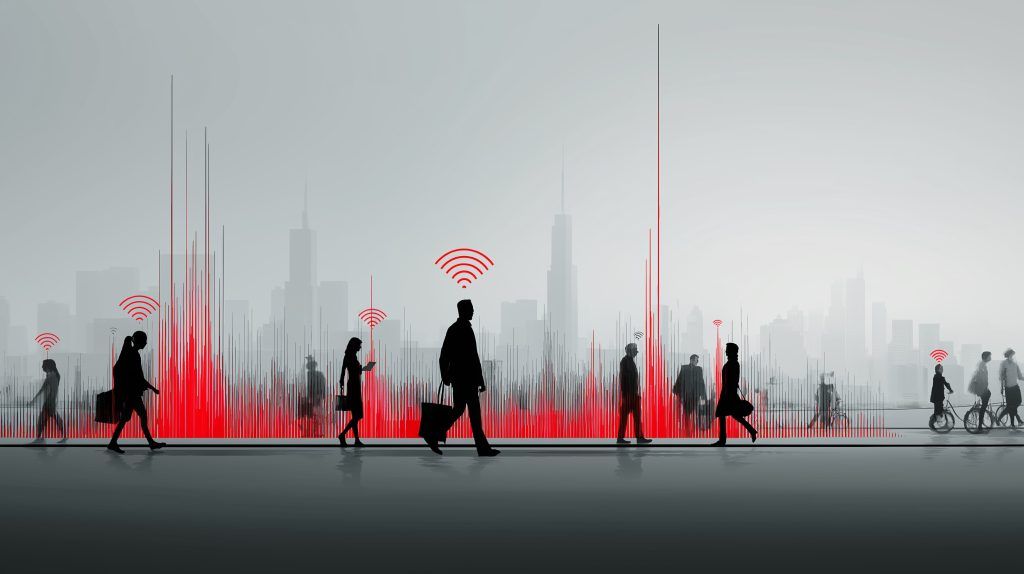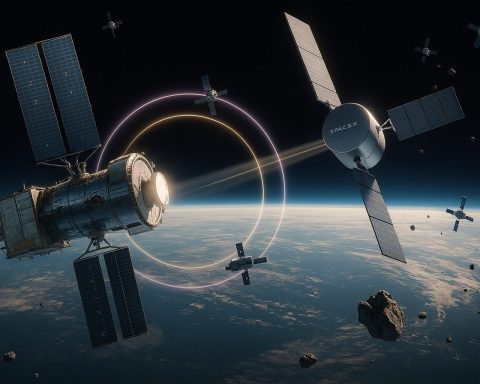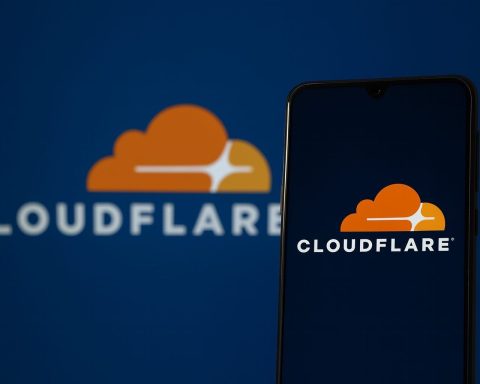- Rwanda’s first internet access occurred around 1996, and by 2000 there were about 5,000 users (less than 0.1% of the population).
- In 2004 Rwanda privatized Rwandatel and sold it to Terracom, opening the ISP market to competition.
- Between 2008 and 2010, Rwanda laid over 3,000 km of national fiber backbone across all 30 districts, linking to SEACOM, EASSy and TEAMS in 2009, driving international bandwidth costs from about $3,000 per Mbps in 2006 to roughly $25 per Mbps.
- In 2013, Korea Telecom Rwanda Networks (KTRN) built a nationwide 4G network on a wholesale-only basis, achieving over 95% population coverage by 2018.
- As of early 2024, Rwanda had 12.2 million mobile connections (about 86% of the population) and 9.27 million mobile internet subscriptions, while fixed broadband stood at about 62,000 lines.
- In 2019, the Icyerekezo satellite with OneWeb connected schools on Nkombo Island, the RwaSat-1 3U CubeSat was launched, and the Rwanda Space Agency was established in 2020.
- In February 2023, Rwanda granted Starlink an operating license and launched a pilot to connect 500 schools; service went live by March 2023, and by end-2023 there were 3,448 Starlink subscriptions.
- In 2022 the government began reconsidering the wholesale-only 4G model to allow more competition in future networks.
- In June 2025 MTN Rwanda launched the country’s first 5G service in Kigali, with plans to expand to other cities.
- Connect Rwanda began in 2019 to donate smartphones to households, aiming to boost smartphone ownership among low-income families.
Rwanda has emerged as one of Africa’s digital trailblazers, transforming from a nation with almost no internet access in the 1990s to an ambitious ICT hub today. This report delves into Rwanda’s internet revolution – from the historical rollout of infrastructure to the latest efforts connecting remote villages and even leveraging satellites for connectivity. We examine how Rwanda built its networks, current access statistics, major players and technologies, government policies (like the Smart Rwanda Master Plan), the urban-rural digital divide, affordability issues, the advent of satellite internet via Starlink and others, comparisons with neighbors, and what the future holds for Rwanda’s digital infrastructure.
Historical Development of Internet Infrastructure in Rwanda
Rwanda’s journey into the internet age began in the mid-1990s on a very limited scale. The country’s first internet access was launched around 1996, but uptake was negligible in the early years [1]. By the year 2000, Rwanda had only on the order of a few thousand internet users (roughly 5,000 users, or <0.1% of the population) [2], reflecting how nascent the technology was in a post-war economy. The early 2000s saw critical liberalization moves – notably the 2004 privatization of the state telecom Rwandatel (to Terracom), which injected new investment and opened the ISP market to competition [3]. This led to the first significant bump in connectivity. By 2010, internet users had grown to over 500,000 (about 5.3% of Rwandans) [4], marking the initial leap from a virtually offline society to one with a modest online presence.
A cornerstone of Rwanda’s strategy was a series of five-year National Information and Communication Infrastructure (NICI) plans launched in the early 2000s. Under NICI I (2000–2005), Rwanda focused on creating an enabling environment – establishing a regulatory framework and opening the telecom sector to competition [5]. Subsequent NICI plans drove infrastructure build-out. Around 2008–2010, Rwanda executed a major national fiber optic backbone project, with over 3,000 km of fiber laid to connect all 30 districts [6]. This backbone linked Rwanda to undersea cables via neighboring countries, a game-changer for the landlocked nation. In 2009, the government, with World Bank support, secured connectivity to several new submarine cables (SEACOM, EASSy, TEAMS) through Uganda and Kenya [7] [8]. As international fiber links came online, the cost of bandwidth plummeted – from about $3,000 per Mbps via satellite in 2006 to roughly $25 per Mbps after fiber, a 99% price drop [9]. This vastly increased Rwanda’s international bandwidth and ended its dependence on expensive VSAT links.
By the early 2010s, the groundwork was laid: a national fiber grid, multiple international gateways, and a growing base of mobile networks. Mobile telephony expanded rapidly in the 2000s, with MTN Rwanda launching GSM services and new competitors entering (e.g. Tigo in 2009, later merged with Airtel). Internet remained mostly 2G/3G-based until the next inflection point: the introduction of 4G LTE. In 2013, Rwanda struck an innovative deal with Korea Telecom to deploy a nationwide 4G network on a wholesale-only basis [10]. The joint venture, KT Rwanda Networks (KTRN), built out 4G infrastructure across the country, leasing capacity to retail operators like MTN and Airtel. The results were dramatic – by 2018 Rwanda had 4G LTE coverage reaching over 95% of the population, the first country in Africa to achieve near-ubiquitous 4G coverage [11]. Within just four years of launch, Rwanda’s 4G signal blanketed all districts, including rural areas that previously lacked broadband access [12]. This rapid rollout of 4G underpinned the government’s vision of leapfrogging into the digital era after having “missed the agricultural and industrial revolutions,” as President Paul Kagame famously noted [13].
Current Internet Access: Penetration and Usage Statistics
Rwanda’s internet usage has climbed steadily, especially in the past decade, but a large portion of the population remains offline. As of early 2024, about 4.91 million Rwandans were internet users, representing an internet penetration rate of 34.4% of the population [14]. This was up from 30.5% (4.25 million users) at the start of 2023 [15]. Growth continues: by mid-2025, internet penetration reached approximately 38% (around 5.5 million users), finally matching the African continental average and marking a significant milestone [16]. The government has set an ambitious target of universal internet access (approaching 100% usage) by 2030 [17], though reaching the most isolated and low-income citizens remains a challenge.
Internet access in Rwanda today is overwhelmingly driven by mobile networks. There were over 12.2 million mobile cellular connections active in early 2024, equivalent to 86% of the population – indicating many people have multiple SIM cards [18]. By contrast, fixed broadband subscriptions are scant (only about 62,000 fixed lines by late 2023) [19]. In fact, RURA’s statistics show that as of December 2023, virtually all internet subscriptions (over 9.27 million) were via mobile SIMs, with fixed internet accounting for less than 1% of connections [20]. Mobile data (3G/4G) is the primary on-ramp to the internet for Rwandans, while fixed fiber or wireless broadband is still a niche service for enterprises and a small number of urban households [21].
The implication of mobile-centric internet is that most users access online services through smartphones or basic internet-enabled phones. However, smartphone penetration remains a limiting factor. Only about 34% of Rwandan households own a smartphone as of 2025, and just 20% of the population are active mobile internet users (many have SIMs capable of data but don’t use data regularly) [22] [23]. The median age in Rwanda is very young (around 19), yet the majority of people – especially in rural areas – still lack smart devices or digital literacy to use the internet fully [24] [25]. It’s telling that roughly 65% of Rwandans remained offline at the start of 2024 [26], highlighting the gap between network coverage and actual usage.
Those who are connected have seen service quality improve in recent years. Rwanda’s networks offer decent speeds by regional standards. In early 2024, median mobile download speed was about 21 Mbps, and median fixed broadband speed was ~29.5 Mbps (a huge jump from ~10 Mbps a year prior, thanks to fiber upgrades) [27]. The robust national fiber backbone and 4G expansion have reduced congestion and improved reliability. Kigali, the capital, enjoys especially good connectivity, with widespread 4G and even some pilot 5G hotspots. In June 2025, MTN Rwanda launched the country’s first 5G service, aiming to cover Kigali and other cities with ultra-fast, low-latency wireless networks as a next step in infrastructure growth [28]. While 5G is nascent, its launch underscores Rwanda’s commitment to stay at the cutting edge of mobile technology in Africa.
Major Internet Service Providers and Technologies in Use
Rwanda’s internet market is served by a mix of mobile operators, a wholesale network provider, and a few ISPs, all underpinned by varied technologies (fiber, mobile broadband, wireless and satellite). The mobile sector is dominated by two players: MTN Rwanda and Airtel Rwanda. MTN (a subsidiary of South Africa’s MTN Group) is the largest operator, with about two-thirds of mobile subscribers; Airtel (part of India’s Bharti Airtel, which acquired former Tigo Rwanda in 2018) holds most of the remaining one-third share [29]. Together these two companies provide the vast majority of internet access via their 3G and 4G networks. As of mid-2022, MTN had roughly 66% of Rwanda’s mobile internet subscriptions and Airtel had about 32% [30]. They compete on data packages, mobile money, and network coverage, driving down prices (as seen by frequent promotions and some of Africa’s cheapest data rates, discussed below).
Uniquely, 4G LTE infrastructure in Rwanda is operated by a single wholesale provider, KTRN (Korea Telecom Rwanda Networks). KTRN was set up as a public-private venture in 2013 and given exclusive rights to deploy 4G nationwide [31] [32]. It built a modern LTE network which it leases to MTN, Airtel, and other ISPs to sell 4G services. This single wholesale network approach (sometimes called a “network monopoly”) was intended to avoid duplicate infrastructure and accelerate rollout – a goal largely met given 95% population coverage in just 5 years [33]. However, it also meant retail operators had to rely on KTRN’s pricing and may have had less incentive to expand coverage on their own. (Notably, by 2022 the government began reconsidering the wholesale-only model to possibly allow more competition in future 4G/5G networks [34].)
In addition to the mobile carriers, Liquid Telecom (now part of Liquid Intelligent Technologies) is a major player in Rwanda’s internet landscape. Liquid operates an extensive pan-African fiber network and in Rwanda it provides fiber connectivity, IP backbone, and enterprise broadband. Liquid has rolled out fiber-to-the-premises (FTTP) in Kigali and some secondary cities, branded as “Liquid Home” for residential service [35]. This gives a small segment of users high-speed fixed broadband (often via Wi-Fi routers in homes or offices). Other ISPs have historically included Airtel’s fixed division, BSC Ltd, and ISPA, though many consolidated or shifted focus as the big players (MTN/Airtel/Liquid) took the lead. Rwanda Internet Exchange (RINEX) facilitates local traffic exchange in Kigali, helping keep domestic data traffic efficient.
On the technology front, Rwanda’s backbone relies on fiber-optic cables linking all districts and key border points. Fiber carries high-capacity internet across the country and also links Rwanda internationally: fiber routes connect west to DR Congo, north to Uganda, east to Tanzania, and south to Burundi, giving multiple paths to submarine cable landing stations [36] [37]. Within cities, fiber and microwave links connect mobile base stations and provide corporate internet links. Mobile broadband (3G/4G) is the workhorse for delivering internet to users’ devices. 3G covers virtually the entire country (over 98% population coverage), and 4G LTE now covers 95%+ of the population [38]. In practice, many rural areas still mainly use 3G due to fewer 4G towers or cost constraints, but 4G availability has become widespread even in towns and along major roads.
Other technologies also contribute: Fixed wireless access is used in some cases (e.g. point-to-point wireless links to businesses or WiMAX deployments historically). Public Wi-Fi hotspots have been another strategy – since the “Smart Kigali” initiative in 2013, the government and telcos set up free Wi-Fi zones on buses, in parks, and public buildings to spur usage. Satellite links were once critical (before fiber arrival) and now serve niche needs (like remote site connectivity or backup links). And as of 2025, pilot 5G networks are in place in Kigali, which could over time enable new services (IoT, smart city applications, etc.) once devices and coverage expand [39].
In summary, Rwandans primarily access the internet through mobile operators (MTN and Airtel) using 3G/4G networks, while a smaller segment uses fiber or Wi-Fi via ISPs like Liquid. The technology mix spans cutting-edge LTE and fiber in urban hubs to basic GSM and satellite in the remotest pockets – but the overall trend has been continuous modernization, with Rwanda often positioning itself at the forefront of telecom innovation in the region.
Government Policies and Initiatives to Promote Internet Access
Rwanda’s internet revolution has been guided by strong government vision and proactive ICT policies. The leadership, under President Paul Kagame, made ICT-driven development a national priority early on – famously declaring Rwanda’s intent to “take full advantage of the digital revolution” as a path to leapfrog economic development [40]. This high-level commitment translated into concrete plans and institutions that have shaped the sector.
One of the foundational policy frameworks was Vision 2020, a national development plan launched in 2000 that identified ICT as a key pillar for transforming Rwanda into a knowledge-based economy [41]. To implement this, the government created dedicated agencies (e.g. the Rwanda Information Technology Authority, later integrated into the Rwanda Information Society Authority – RISA) and rolled out the NICI five-year plans as noted. By the mid-2010s, after three NICI plans, the focus shifted from basic infrastructure to using ICT for service delivery and innovation. The Smart Rwanda Master Plan (2015–2020) was the next blueprint. This plan set out a roadmap to digitally transform seven key sectors (education, health, finance, agriculture, tourism, governance, and trade) and to make Rwanda a “regional ICT hub” by 2020 [42]. Under Smart Rwanda, initiatives included expanding e-government services, promoting tech startups, digitizing agriculture with IoT, cashless payments, and developing human ICT skills.
One flagship program has been “Digital Ambassadors” – young tech-savvy Rwandans deployed to rural communities to train citizens in digital literacy and usage of online services. By late 2024, over 2,000 digital ambassadors were active across all 30 districts, helping residents learn how to use smartphones, the internet, and e-government platforms, with hundreds more ambassadors being added [43] [44]. This grassroots approach addresses the human capacity gap that often limits effective internet uptake even when infrastructure is present.
Another notable initiative is Connect Rwanda, launched in 2019 as a partnership between the government and MTN. Connect Rwanda called on organizations and individuals to donate smartphones to households that couldn’t afford them, aiming to boost smartphone ownership among the poorest. Through this and similar programs, tens of thousands of phones have been distributed and installment payment plans introduced, lowering barriers to entry for new internet users [45] [46].
On the policy side, Rwanda’s regulatory environment has actively encouraged competition and investment. The Rwanda Utilities Regulatory Authority (RURA) has licensed multiple operators over time, ensured open access to the fiber backbone, and monitored quality and pricing. In recent years, policies have focused on affordability – for example, removing taxes on smartphones and other ICT devices to make them cheaper (though in 2023 some taxes were reintroduced, a move critics warned could hurt device affordability [47]). The government also established a Universal Access Fund to subsidize telecom infrastructure in underserved areas. By 2022, these efforts helped Rwanda rank 1st in East Africa on the Affordability Drivers Index (and 32nd globally), reflecting solid policy frameworks to reduce internet costs [48] [49].
Infrastructure-sharing has been another policy mandate. The wholesale 4G network with KT was one example; others include requiring mobile companies to share tower infrastructure and coordinating fiber deployment among utilities. Rwanda has also welcomed foreign partnerships and funding to accelerate connectivity. It was the host of the International Telecommunication Union’s “Connect Africa” summit in 2007, underscoring its role as a continental ICT leader [50]. In the 2010s, the government partnered with organizations like the World Bank, China Exim Bank, and others to finance broadband projects, and with philanthropic initiatives (e.g. One Laptop per Child, which provided hundreds of thousands of schoolchildren with low-cost laptops and internet access).
A signature vision from the government is to transform Rwanda into a “Smart Nation”. Kigali, designated a Smart City, introduced cashless buses with Wi-Fi, smart street lighting, and public service apps. The Smart Village concept is being piloted to bring telemedicine, e-learning, and e-commerce to rural villages via connectivity. Under the ICT Sector Strategic Plan (2024–2029) – the latest five-year plan – Rwanda aims to integrate all citizens, businesses, and government operations into a seamless digital ecosystem [51]. The plan aligns with Vision 2050, which looks to consolidate Rwanda’s status as a middle-income country powered by technology and innovation [52].
Crucially, the government’s push is not just about technology for its own sake, but about inclusive development. That’s why so many initiatives (from school connectivity to digital literacy campaigns) target rural and disadvantaged groups. The leadership recognizes that closing the digital divide is essential for Rwanda to realize its socio-economic goals. As Minister of ICT Paula Ingabire put it, Rwanda’s approach has been “ICT for All”, ensuring that even remote communities are not left behind in the internet revolution. The following sections on rural connectivity and affordability delve deeper into these equity challenges and efforts.
Urban vs. Rural Internet Coverage and Usage
Like many countries, Rwanda faces a significant urban-rural digital divide. Internet access and usage are heavily skewed toward urban centers, especially the capital city Kigali, while rural areas lag in both infrastructure and adoption. Recent surveys starkly illustrate this gap. According to the national Integrated Household Living Conditions Survey (EICV7), 57% of urban residents use the internet, versus only 19% of rural residents [53]. In other words, a majority of city dwellers are online, but in the countryside internet use is still the exception rather than the norm.
Coverage of network infrastructure in rural Rwanda has improved dramatically, but not yet fully equalized with urban areas. On paper, over 95% of the population has 4G or at least 3G signal available [54], and 1,760 telecom towers cover about 96% of inhabited areas as of 2025 [55]. This means most villages are technically within range of mobile internet. However, signal strength can be weaker or speeds slower in some remote locations, and a small fraction of settlements in very rugged terrain might still have patchy reception. The government continues to address remaining “last-mile” gaps – for instance, an additional 840 towers are planned by 2028 to densify the network and reach isolated pockets [56]. Initiatives like rural communication centers and community Wi-Fi zones also aim to provide connectivity hubs in areas where individual household internet is scarce.
Despite near-universal network coverage, actual usage in rural areas is held back by other factors: lack of devices, cost of data relative to incomes, and lower digital literacy. Many rural Rwandans are farmers with low disposable income; smartphones and data plans often compete with basic needs in household budgets. As one observer noted, “people would rather use money to feed themselves than buy a phone” [57]. This dynamic results in rural families that may have mobile phones for calls (basic feature phones) but do not regularly access the internet. By contrast, in cities like Kigali, education levels are higher and smartphones are ubiquitous among the youth and working population, leading to far greater internet uptake.
To tackle these disparities, Rwanda has launched targeted rural connectivity programs. A major effort has been connecting schools in rural and island communities. Through partnerships with telecom operators and satellite companies (discussed in the next section), hundreds of schools in remote areas have been given internet access, effectively turning them into community digital hubs. For example, the Icyerekezo satellite (launched in 2019 in collaboration with UK-based OneWeb) was used to connect schools on Nkombo Island, a remote area in Lake Kivu [58]. Similarly, the government has been rolling out fiber and high-speed wireless to all secondary schools and health centers nationwide, so that even villages in the mountains have at least one connected institution. As of 2022, the government reported having extended broadband connectivity to over 700 public institutions (schools, clinics, local government offices) across the country as part of earlier World Bank-funded programs [59].
Community access points are another strategy. In earlier years, telecenters were established in rural towns – offering public internet access and ICT training. Today, with mobile coverage everywhere, the emphasis has shifted to ensuring every village has some internet access via shared facilities (like school computer labs with Wi-Fi that locals can use after hours) or subsidized micro-ISPs. The “Gira ICT” program (loosely translated as “Have ICT”) encouraged entrepreneurship in setting up village cybercafés and phone charging kiosks.
Despite these efforts, the usage gap remains significant – the urban internet penetration (57%) is triple the rural rate [60]. This gap is not just an infrastructure issue now, but one of affordability and awareness. Rural users, often older and less educated, may not see the immediate value of the internet in their daily lives, or they may fear the costs. The digital ambassador program mentioned earlier explicitly focuses on rural and underserved areas to drive awareness – teaching farmers how they can check crop prices on a phone, or helping small businesses in villages go online to reach new customers. As these efforts continue and as device costs fall, Rwanda hopes to narrow the divide. Indeed, progress is being made: rural internet usage (19%) in 2023 was up from around 9% in 2017 [61], showing a positive trend.
In summary, while Kigali and other cities enjoy high connectivity and an expanding tech scene, rural Rwanda is only at the early stages of internet adoption. The government recognizes this and has oriented many of its policies (subsidies, school connectivity, training) to lift up rural areas. Bridging this urban-rural gap is critical for Rwanda’s goal of inclusive digital development – the internet revolution must ultimately reach the hills of every province, not just the Kigali skyline.
Affordability and Pricing Trends
Rwanda has made notable strides in making internet access more affordable, even ranking as one of Africa’s best performers on cost, but internet service is still expensive for the poorest and pricing remains a barrier for many. Mobile data prices in Rwanda are among the cheapest on the continent – the average price for 1GB of data was about $0.55 in 2023, the 6th-lowest in Africa [62]. (By comparison, the Africa average is around $5 per GB, and some countries in the region charge $1 to $3 for 1GB.) Aggressive competition between MTN and Airtel, along with supportive regulation, has driven prices down. In fact, a report by Cable.co.uk found that in 2023 Rwanda’s data prices were lower than those of wealthier neighbors Kenya and Tanzania, making it the most affordable in East Africa [63]. Rwandans paid an average of $43 per month for a fixed broadband package in 2024, down from $61 the year before – a 29% drop – while equivalent plans cost $47 in Kenya and over $52 in Uganda [64].
It’s important to note, however, that “affordable” is relative. Rwanda may top affordability rankings in Africa, but for the average Rwandan, incomes are very low (GDP per capita is around $900). According to the Alliance for Affordable Internet, 1GB of mobile data in 2022 cost around 3.5% of an average Rwandan’s monthly income [65]. This exceeds the UN Broadband Commission’s target of 2% income for 1GB. For the bottom 40% of earners in Rwanda, 1GB of data cost over 15% of their monthly income as of 2022 [66] – an exorbitant amount. In practical terms, while 1GB might be only $0.50, someone in a rural village earning very little might have to prioritize basic needs and cannot spare even that $0.50 regularly. Moreover, devices are a big part of affordability: a basic smartphone in Rwanda costs around $40-$60, while a decent Android phone is $100+; the TechCabal report noted the “typical smartphone” was $160 in 2025 [67]. For low-income households, buying a smartphone plus a data plan can consume up to 60% of monthly income – effectively pricing them out [68].
The government and operators have used several tactics to improve affordability. These include price competition (Airtel famously introduced ultra-cheap social media bundles and MTN responded in kind), tax exemptions on smartphones and telecom equipment (which were in place for several years to reduce device costs), and smaller, more flexible data bundles to lower the entry barrier. For example, Rwandans can buy daily or even hourly data passes for a few cents, rather than having to buy a 1GB monthly plan. This pay-as-you-go model aligns with irregular income flows of many users. As a result, while only ~20% of Rwandans were regular mobile internet users in 2025, many more use it occasionally when they can afford a small top-up [69].
Another positive trend is that international bandwidth costs have fallen, thanks to additional undersea cable capacity and Rwanda’s own internet exchange. This has allowed ISPs to gradually offer more data for the same price and improve speeds. In the early 2010s, 1 Mbps of dedicated internet cost hundreds of dollars; today, home fiber packages of 10 Mbps or more are offered at monthly rates around $40–$50 [70] (still high for most, but a vast improvement). The fact that Rwanda’s average broadband cost dropped nearly 30% from 2023 to 2024 shows momentum in the right direction [71].
Notably, Rwanda’s telecom market benefits from conscious pro-consumer regulation. RURA keeps an eye on tariffs and has periodically intervened to reduce interconnection fees and other charges, enabling cheaper phone and internet services. The country’s SIM registration and mobile money penetration also indirectly boost affordability – widespread use of mobile money has facilitated innovative data lending services or “reverse billing” (where a business can sponsor data for users, e.g., an e-government app that citizens can access free of data charge).
Despite low data prices by African standards, the affordability challenge is far from solved. Poverty remains the number one barrier to internet use in Rwanda [72]. This is why programs like Connect Rwanda (donating smartphones) and digital skills training are vital; they help more people perceive the value of connectivity so that spending even a small amount on data becomes worthwhile to them. As more Rwandans cross the poverty line and as device costs continue to come down (perhaps with influx of very low-cost smartphones), internet adoption should accelerate.
Finally, it’s worth mentioning that Starlink and other satellite services, while now available, are not priced for the average consumer and thus aren’t part of the affordability solution for general population (a Starlink kit in Rwanda costs several hundred dollars plus a monthly fee around $50-$100, far above what most can pay) [73]. Those services are aimed more at institutions and high-end users or as community shared solutions. The next section explores Rwanda’s ventures into satellite internet, which are more about reaching remote areas than solving mass-market affordability.
Internet Over Satellite: Starlink and Other Initiatives
In its drive to connect even the most remote parts of the country, Rwanda has embraced satellite internet as a complementary solution to terrestrial networks. The mountainous terrain and some isolated communities (like islands in Lake Kivu) mean that reaching 100% coverage with land-based infrastructure can be cost-prohibitive. Satellite connectivity offers a way to beam internet to areas where laying fiber or building cell towers is impractical. In recent years, Rwanda has launched or partnered on several satellite projects, including both traditional geostationary satellites and newer low-Earth orbit (LEO) constellations.
One pioneering step was taken in February 2019, when Rwanda collaborated with the U.K.-based company OneWeb to launch the satellite “Icyerekezo” (meaning “Vision” in Kinyarwanda). Icyerekezo was one of OneWeb’s first batch of LEO satellites and was symbolically named by Rwandan students, reflecting the nation’s hopes for space-enabled connectivity. The satellite’s immediate purpose was to provide broadband internet to schools in remote areas, and indeed it was used to connect students on Nkombo Island (a rural community in Lake Kivu) who previously had no reliable internet [74]. This initiative demonstrated early on how satellites could link Rwanda’s underserved communities – a student on an island could browse educational content online thanks to a satellite overhead.
Building on that, Rwanda established the Rwanda Space Agency (RSA) in 2020, signaling its intention to be active in satellite technology. The country even launched its first entirely home-grown nanosatellite, RwaSat-1, in 2019 (a 3U CubeSat developed with support from Japan) [75]. RwaSat-1’s mission was mainly earth observation (for agriculture and environmental monitoring), not internet, but it helped build local expertise. More ambitiously, in 2021 Rwanda filed with the ITU to reserve orbital slots for two large satellite constellations totaling over 327,000 satellites [76] [77]. While Rwanda is unlikely to build such constellations alone, the filings (in partnership with a startup from the U.S.) were a strategic move to become a player in the satellite broadband arena – potentially positioning Rwanda as a hub for future satellite operations or partnerships.
The headline development in satellite internet has been the arrival of Starlink, Elon Musk’s SpaceX’s satellite internet service. Rwanda moved quickly to engage Starlink: it issued Starlink an operating license in early 2023, making it one of the first African countries to do so [78]. By March 2023, Starlink service was live in Rwanda, marking the company’s second launch in Africa (just after Nigeria) [79] [80]. Even before the commercial rollout, the government partnered with Starlink on a pilot to connect schools. In February 2023, a pilot scheme began equipping 500 schools with Starlink kits to deliver high-speed internet to those campuses [81]. These were primarily schools in rural and underserved areas, again reflecting the strategy of reaching the unreached via satellite. The Ministry of ICT confirmed this plan, noting that while Starlink’s direct-to-consumer service is pricey, its school connectivity pilot would bring these otherwise isolated schools online [82] [83].
Starlink’s impact in Rwanda is already visible in some ways. By the end of 2023, RURA reported that 3,448 Starlink subscriptions were active in the country [84]. Many of these are likely institutions, NGOs, or businesses needing reliable connectivity in rural locales (for instance, eco-lodges, research stations, or community centers far from fiber). Additionally, Starlink has been touted as a backup for disaster resilience – given Rwanda’s hilly geography and occasional landslides, having satellite backup links can ensure continuity of internet in case terrestrial networks go down [85].
Beyond Starlink, traditional satellite providers continue to serve Rwanda. Companies like Avanti (Hylas satellites) or YahClick have provided Ka-band satellite broadband in Rwanda for years, mainly to enterprise and government clients. For example, prior to fiber, the government itself used substantial satellite bandwidth – in 2006 Rwanda was purchasing only 1 Mbps of satellite internet at about $2,500 per month [86]! Those days are gone for mainstream connectivity, but VSAT remains an option for remote clinics or off-grid facilities. Rwanda’s embrace of LEO doesn’t eliminate GEO satellites; rather, the two can complement each other (LEO for low-latency needs, GEO for broadcasting and reaching many sites with one beam).
The Rwandan government’s space agenda also includes leveraging satellite tech for other uses that indirectly benefit connectivity – for instance, mapping for better network planning, or even exploring drone and high-altitude platform systems. Notably, Rwanda was an early adopter of delivery drones for medical supplies (Zipline drones), showing openness to innovative airborne solutions. It wouldn’t be surprising if, in the coming years, Rwanda partners in projects like Project Loon (balloon internet) or other novel connectivity solutions targeting rural coverage.
In summary, Rwanda is literally reaching for the sky to connect its citizens. By launching its own educational satellite, partnering on OneWeb’s constellation, and being an early host for Starlink, Rwanda signals that no village should be too remote to benefit from the internet. A village in a valley with no cell tower may soon get online via a satellite dish on the school roof. These efforts complement the ground-based networks and accelerate progress toward universal access. They also place Rwanda on the map as a leader in adopting cutting-edge connectivity technologies in Africa.
Regional Comparisons: Rwanda vs. Other East African Countries
Within East Africa, Rwanda’s internet progress is often viewed as a success story, though it faces many of the same challenges as its neighbors. Comparing key indicators shows that Rwanda is punching above its weight in some areas (coverage, affordability), while still catching up in others (overall penetration, speeds) given its smaller economy.
In terms of internet penetration, Rwanda’s ~38% of population online (mid-2025) is roughly on par with the African average and has now caught up to countries like Tanzania, but it trails continental leaders like Kenya [87] [88]. For instance, Kenya’s internet penetration stood at about 40.8% in January 2024 [89]. Kenya historically has been a regional leader, benefiting from earlier undersea cable access (since 2009) and the boost of mobile innovations like M-Pesa which drove smartphone adoption. Uganda and Tanzania lag a bit behind – Uganda was around 27% in 2024 [90] and Tanzania ~32% in 2024 [91] – so Rwanda (34% in 2024) was ahead of Uganda and roughly even with Tanzania in that period [92] [93]. Tiny Burundi remains much lower (around 15% or less) and new EAC entrant South Sudan lower still, due to instability. So within the East African Community, Rwanda ranks near the top for proportion of people online, second only to Kenya as of the mid-2020s.
Where Rwanda really shines is network coverage and infrastructure metrics. By achieving 95% 4G coverage, Rwanda leapfrogged its neighbors – for example, Kenya’s 4G network, while extensive, covers around 90% of the population; Uganda and Tanzania have even less 4G footprint in rural areas. The number of towers per capita in Rwanda is quite high, and the country has been aggressive in rolling fiber to all districts. A regional telecom report noted that Rwanda led the region with a 99% mobile network coverage rate (population coverage) as early as 2019, ahead of larger countries with difficult terrains [94]. This intensive infrastructure is a result of Rwanda’s small size and focused investments.
On speed and quality, Rwanda’s mobile and fixed broadband speeds are decent but not top in region – Kenya, with its urban fiber in Nairobi and multiple 4G operators, often records higher average speeds. However, differences are narrowing as Rwanda upgrades its networks. All countries in the region have some initiatives around 5G now: Rwanda launched in 2025, Kenya and Uganda trialed 5G in 2022-2023 in select areas.
Perhaps Rwanda’s most distinctive edge is in affordability and policy environment. As mentioned, it offers the most affordable broadband in EAC, with average monthly costs lower than in Tanzania or Kenya [95]. This is significant because price is a major determinant of adoption. Rwanda’s regulators and government incentives have created one of the friendliest markets for consumers. A 2021 index by the Economist ranked Rwanda 1st in Low-Income Africa on the Inclusive Internet Index’s affordability pillar [96]. Additionally, Rwanda is known for its relative ease of doing business and public-private collaboration in ICT, which attracts investment. Neighboring countries are sometimes held back by more fragmented regulatory regimes or monopolies (for example, Ethiopia – outside EAC – only recently liberalized telecom, whereas Rwanda did so two decades ago).
That said, Rwanda also faces some unique challenges due to its demographics – a very young, rural-heavy population with low purchasing power, similar to Uganda or Burundi in that sense. Kenya’s more urbanized populace and bigger economy naturally gives it a larger internet user base (Kenya has ~22 million users vs Rwanda’s ~5 million) [97] [98]. So while percentages can be similar, the scale is different.
In broader comparisons, Rwanda’s narrative is often contrasted with Ethiopia’s (both seen as developmental states with ICT ambitions). Observers note that Rwanda managed to pursue an ICT-for-development model that is more open and multi-actor (involving private sector, foreign partners, and a relatively freer internet space) as opposed to Ethiopia’s tightly controlled telecom monopoly approach in the past [99] [100]. The result is that Rwanda achieved higher internet penetration and service rollout at a lower income level than Ethiopia did by the mid-2010s [101].
Within East Africa, Kenya remains the regional powerhouse for tech startups and internet applications, but Rwanda has carved out a niche as a testbed for innovation. It hosted the Transform Africa Summit, set up one of Africa’s first drone delivery networks, and launched the Center for the Fourth Industrial Revolution (a WEF-affiliated initiative) in Kigali in 2018 [102]. These moves position Rwanda as a forward-looking player, sometimes giving it an outsized influence relative to its small population.
In summary, Rwanda compares favorably with its neighbors on many internet metrics: it is among the leaders in penetration rate, tops in coverage and affordability, and very high in political commitment to ICT. Challenges like rural access and cost to users are shared across the region, but Rwanda’s concerted efforts have often put it a step ahead. As East African countries collectively advance (all are seeing internet growth year over year), Rwanda’s experience – the policies that worked, the investment in infrastructure, the focus on inclusion – is increasingly seen as a model that others study when formulating their own digital agendas.
Future Outlook and Investment Trends in Digital Infrastructure
Rwanda’s internet revolution is poised to continue accelerating in the coming years, with significant investments and plans underway to deepen digital penetration and transform the economy. The future outlook is one of optimism tempered with realism about the remaining gaps to fill.
On the infrastructure front, Rwanda will focus on extending coverage and capacity even further. The plan to add 840 new towers by 2028 [103] will improve network quality in rural areas and increase capacity in urban centers to handle growing data demand. 5G expansion is expected to ramp up: after MTN’s initial 5G launch in Kigali in 2025, we can anticipate both MTN and Airtel (possibly via KTRN or independently if policy shifts) to roll out 5G to other cities and eventually some industrial zones. 5G will enable advanced use-cases – from smart city sensors to telemedicine with real-time video – but realistically, mass 5G adoption in Rwanda may be a few years away given device costs and the fact that 4G itself still has plenty of room to grow in usage.
Fiber-optic infrastructure will also see new investments. Rwanda intends to upgrade its national backbone to increase capacity (e.g., deploying higher-count fibers or modern DWDM equipment to carry more bandwidth). There are also plans to push fiber closer to end-users – for instance, expanding fiber-to-the-home in Kigali and to more businesses nationwide [104]. The government’s Smart City master plans for secondary cities include laying metro fiber rings and public Wi-Fi in places like Musanze, Huye, and Rubavu, so that economic growth isn’t limited to the capital.
One important trend is regional integration of connectivity. Rwanda is landlocked, so it relies on regional cooperation for international bandwidth. The EAC countries are working on initiatives like the One Network Area (which already slashed roaming charges) and cross-border fiber projects. Rwanda stands to benefit from new submarine cables on Africa’s east coast (for example, the planned “2Africa” cable extension into the Indian Ocean, or other future systems), likely accessed via Uganda/Kenya. More international bandwidth coming online usually translates to lower wholesale prices and better resilience (so outages on one route don’t cut off the country). Indeed, Rwanda now has “multiple routes to submarine cables,” including new Points of Presence like a SEACOM PoP established in Kigali in 2022 [105]. This makes the internet in Rwanda faster and more reliable, which is crucial for the country’s goal of becoming an ICT hub.
In terms of policy and initiatives, the next few years will see the execution of the ICT Sector Strategic Plan 2024–2029, which emphasizes digital inclusion, cybersecurity, and digital skills. By 2030, Rwanda aims not only for universal access but also for the digital economy to form a large share of GDP. This implies support for innovation – expect continued investment in tech incubators (like kLab in Kigali), promotion of coding in schools, and perhaps new incentives for tech companies (Rwanda already created a Special Economic Zone in Kigali for ICT companies with perks). E-government 2.0 is also on the horizon: Rwanda’s Irembo platform (online government services) will likely expand with more services and deeper integration, possibly using AI and data analytics to improve service delivery. The government’s vision of a cashless, paperless society will drive further expansion of broadband so that every citizen can access public services online.
Another emerging area is local content and services. As more Rwandans come online, there will be a push for more content in Kinyarwanda, more local apps (for farming, commerce, health, etc.), and leveraging connectivity for socio-cultural development. The education sector, for example, is set to use internet connectivity for distance learning – a trend accelerated by the COVID-19 pandemic. With all secondary schools connected, Rwanda can implement nationwide e-learning programs or remote tutoring for rural schools.
On the cutting edge, Rwanda’s leadership in space and satellite initiatives could yield fruit in the latter half of this decade. The filings for mega-constellations might attract global players to partner with Rwanda (for instance, a company could use Rwanda’s ITU filing to deploy satellites with some operations anchored in Rwanda). This could mean new ground stations in Rwanda, or even assembly/testing facilities for satellites, spurring high-tech job creation. The Rwanda Space Agency’s plans for additional RwaSat satellites in coming years will support development goals (e.g., agriculture monitoring, IoT connectivity). If E-Space (the mentioned startup) or others move forward on LEO constellations via Rwanda, the country might become a regional gateway for satellite internet traffic, complementing its terrestrial fiber gateways.
One cannot forget the financial side – significant investment will be required for these plans. The government has historically secured funding from multi-lateral development banks and PPP arrangements (public-private partnerships). We anticipate more PPPs especially in rural connectivity (similar to how Korea Telecom invested $140 million for 4G [106]). In 2022, for example, the government reversed a previous plan to rely solely on the wholesale network, signaling openness to more private investment in last-mile networks [107]. Tower companies may step in to build the remaining towers (the majority of existing towers are operated by IHS Rwanda). Also, Rwanda may tap into global funds for digital inclusion – the ITU/UNICEF Giga initiative that focuses on connecting schools is one such avenue that could bring grants or soft loans to achieve the “internet for every school, every community” goal.
Looking ahead, by 2030 we could see Rwanda nearing 80-90% internet use if current trajectories hold, with most adults connected and basic internet considered a utility like electricity (which itself is being expanded rapidly). The challenges are real – affordability for the poorest, ensuring that increased internet use doesn’t exacerbate inequality, and guarding against cyber threats as more critical services go online. Rwanda has already been working on cybersecurity and data protection laws to create a safe digital environment. Freedom on the Net reports have rated Rwanda as “partly free,” noting some internet censorship and surveillance concerns [108]. Balancing security with openness will be part of the policy evolution as well.
In conclusion, Rwanda’s internet revolution is far from over – it is entering a new phase of maturity. Having built out foundational infrastructure and achieved respectable penetration, the country is now doubling down on universal access, next-gen technologies like 5G and satellites, and digital services uptake. The investments made over the past two decades have laid a strong base. If Rwanda continues on this path, it is poised to realize its vision of a fully connected nation where even a farmer in a remote village can video-chat with a doctor or sell produce online, and where the launch of satellites and development of tech solutions happen not as one-off stories but as a routine part of the economy. The “internet revolution” in Rwanda is increasingly looking irreversible – a permanent change that will drive the country’s development in the decades to come.
Sources:
- Historical context and first internet access: Mlay et al., Global Diffusion of the Internet: The Internet in Rwanda, 2013 [109]; RURA & ITU statistics via UNESCO [110].
- Infrastructure development and fiber backbone: The EastAfrican (World Bank project, 2008) [111] [112].
- 4G LTE rollout and coverage: SAMENA Council news (KTRN 95% coverage by 2018) [113].
- Current usage stats: DataReportal Digital 2023 and 2024 Rwanda reports [114] [115]; TechCabal 2025 update (38% penetration) [116].
- Mobile vs fixed subscriptions: RURA Q4 2023 report (mobile SIM internet vs fixed) [117].
- Mobile connections and population: DataReportal [118].
- Speeds: DataReportal (Ookla data) [119].
- 5G launch: New Times via TechCabal [120].
- Market share of ISPs: Freedom House (quoting RURA) [121].
- KTRN wholesale model: SAMENA Council [122]; GSMA report via Freedom House [123].
- Liquid Telecom expansion: Freedom House [124].
- Historical pricing (2006 satellite cost): KT Press [125].
- Government ICT vision: Stability Journal (Kagame quote) [126].
- Digital Ambassadors, smartphone stats, rural-urban usage: TechCabal 2025 [127] [128] [129].
- Affordability metrics: Business Insider Africa (1GB ~$0.55, 6th in Africa) [130]; Sputnik (Rwanda lowest broadband cost in EAC) [131]; Freedom House (A4AI index and % of income data) [132].
- Starlink in Rwanda: Business Insider Africa (Starlink in 7 African countries by Oct 2023) [133]; TeleGeography (500 schools pilot, 3,448 subs by end 2023) [134].
- OneWeb/Icyerekezo and RwaSat-1: Africa Defense Forum [135].
- East Africa comparisons: DataReportal Kenya, Uganda, Tanzania [136] [137] [138]; Sputnik/Cable (costs) [139]; Freedom House/ITU (Rwanda vs others) [140].
References
1. www.researchgate.net, 2. www.unesco.org, 3. www.researchgate.net, 4. www.unesco.org, 5. www.researchgate.net, 6. www.un.org, 7. www.theeastafrican.co.ke, 8. www.theeastafrican.co.ke, 9. www.theeastafrican.co.ke, 10. www.samenacouncil.org, 11. www.samenacouncil.org, 12. www.samenacouncil.org, 13. stabilityjournal.org, 14. datareportal.com, 15. datareportal.com, 16. techcabal.com, 17. techcabal.com, 18. datareportal.com, 19. rura.rw, 20. rura.rw, 21. rura.rw, 22. techcabal.com, 23. techcabal.com, 24. datareportal.com, 25. techcabal.com, 26. datareportal.com, 27. datareportal.com, 28. techcabal.com, 29. freedomhouse.org, 30. freedomhouse.org, 31. www.samenacouncil.org, 32. www.samenacouncil.org, 33. www.samenacouncil.org, 34. freedomhouse.org, 35. freedomhouse.org, 36. www.theeastafrican.co.ke, 37. www.theeastafrican.co.ke, 38. www.samenacouncil.org, 39. techcabal.com, 40. stabilityjournal.org, 41. www.theeastafrican.co.ke, 42. www.theigc.org, 43. techcabal.com, 44. techcabal.com, 45. techcabal.com, 46. techcabal.com, 47. techcabal.com, 48. freedomhouse.org, 49. freedomhouse.org, 50. en.wikipedia.org, 51. techcabal.com, 52. techcabal.com, 53. techcabal.com, 54. www.samenacouncil.org, 55. techcabal.com, 56. techcabal.com, 57. techcabal.com, 58. adf-magazine.com, 59. www.theeastafrican.co.ke, 60. techcabal.com, 61. allafrica.com, 62. africa.businessinsider.com, 63. en.sputniknews.africa, 64. en.sputniknews.africa, 65. freedomhouse.org, 66. freedomhouse.org, 67. techcabal.com, 68. techcabal.com, 69. techcabal.com, 70. en.sputniknews.africa, 71. en.sputniknews.africa, 72. freedomhouse.org, 73. freedomhouse.org, 74. adf-magazine.com, 75. adf-magazine.com, 76. adf-magazine.com, 77. adf-magazine.com, 78. africa.businessinsider.com, 79. africa.businessinsider.com, 80. blog.telegeography.com, 81. blog.telegeography.com, 82. freedomhouse.org, 83. freedomhouse.org, 84. blog.telegeography.com, 85. blog.telegeography.com, 86. www.ktpress.rw, 87. techcabal.com, 88. datareportal.com, 89. datareportal.com, 90. datareportal.com, 91. datareportal.com, 92. datareportal.com, 93. datareportal.com, 94. eaco.int, 95. en.sputniknews.africa, 96. freedomhouse.org, 97. datareportal.com, 98. datareportal.com, 99. stabilityjournal.org, 100. stabilityjournal.org, 101. stabilityjournal.org, 102. stabilityjournal.org, 103. techcabal.com, 104. freedomhouse.org, 105. www.capacitymedia.com, 106. freedomhouse.org, 107. freedomhouse.org, 108. stabilityjournal.org, 109. www.researchgate.net, 110. www.unesco.org, 111. www.theeastafrican.co.ke, 112. www.theeastafrican.co.ke, 113. www.samenacouncil.org, 114. datareportal.com, 115. datareportal.com, 116. techcabal.com, 117. rura.rw, 118. datareportal.com, 119. datareportal.com, 120. techcabal.com, 121. freedomhouse.org, 122. www.samenacouncil.org, 123. freedomhouse.org, 124. freedomhouse.org, 125. www.ktpress.rw, 126. stabilityjournal.org, 127. techcabal.com, 128. techcabal.com, 129. techcabal.com, 130. africa.businessinsider.com, 131. en.sputniknews.africa, 132. freedomhouse.org, 133. africa.businessinsider.com, 134. blog.telegeography.com, 135. adf-magazine.com, 136. datareportal.com, 137. datareportal.com, 138. datareportal.com, 139. en.sputniknews.africa, 140. stabilityjournal.org
